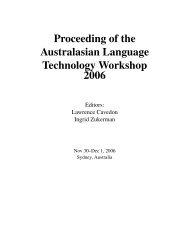The MBC information booklet - RMIT University
The MBC information booklet - RMIT University
The MBC information booklet - RMIT University
Create successful ePaper yourself
Turn your PDF publications into a flip-book with our unique Google optimized e-Paper software.
Chapter 9: Software Engineering<br />
9.1.3 COSC2275—<br />
Software<br />
Requirements<br />
Engineering<br />
9.1.4 ISYS1081—<br />
Software Reuse<br />
9.1.5 ISYS1085—<br />
Software<br />
Testing<br />
40<br />
• Project Management (including Software Life-Cycles)<br />
• Structured Programming (preferably C)<br />
• Knowledge of, and experience using, object-oriented programming (Java or C++) is<br />
necessary to succeed in this course<br />
For more <strong>information</strong> on the course, go to www.rmit.edu.au/courses2006/004185.<br />
Note: This is a Masters-level course.<br />
Course Description<br />
This course presents the key components and processes involved in the effective<br />
creation and governance of enterprise architectures. An enterprise architecture is an<br />
overall framework and strategic objective for the usage of technology over time across<br />
an organization; it provides a plan and objectives that align business goals with ICT<br />
strategy, to enable the organization to make the most effective use of ICT to support and<br />
build the business. Students will acquire knowledge about all of these aspects of<br />
enterprise architectures, learn what the choices are and how to make them for enterprise<br />
architectures, and be able to explain and present their decisions.<br />
Pre-requisite Courses and Assumed Knowledge and Capabilities<br />
• Students will be expected to understand the key processes, knowledge and usage<br />
of software requirements engineering acquired in COSC2275 Software<br />
Requirements Engineering.<br />
• In addition the capabilities being acquired in this course will be complemented by<br />
those acquired in the courses ISYS1088 Systems Architecture and INTE2412 IT<br />
Governance and Change Management.<br />
For more <strong>information</strong> on the course, go to www.rmit.edu.au/courses2006/035217.<br />
Note: This is a Masters-level course.<br />
Course Description<br />
This course is an introduction to systematic software reuse. Topics covered include:<br />
reuse library, component-based development, domain engineering, program generation<br />
and customization, and software product lines. Students will also learn various<br />
techniques for developing reusable software, such as XSLT, Frame Technology,<br />
Templates, Design Patterns and Object-Oriented Framework.<br />
This course is primarily for students who have a software engineering background and it<br />
requires some prior experiences in software development.<br />
Pre-requisite Courses and Assumed Knowledge and Capabilities<br />
• ISYS1117 Software Engineering Analysis and Design<br />
• COSC1295 Java for Programmers<br />
For more <strong>information</strong> on the course, go to www.rmit.edu.au/courses2006/004183.<br />
Note: This is a Masters-level course.<br />
Course Description<br />
This is an introduction to software testing principles and practices in industry. We will<br />
discuss practical software testing goals and approaches to testing software at various<br />
levels - from end user application level to source code level through all phases of the<br />
Software Development Lifecycle. <strong>The</strong> course material will include the following -<br />
software quality standards and metrics, types of testing, function and performance<br />
testing, test planning, test case generation, shipping criteria, estimating test resources,<br />
scheduling tests, object-oriented factors in testing, assessing risks, prioritizing tests,<br />
automation strategy, defect management, test execution, the end game before final<br />
shipping and post ship test and support issues. Software quality assurance activities will<br />
be discussed as part of a dynamic process that is flexible and constantly tuned to the<br />
changing needs of a project.
















